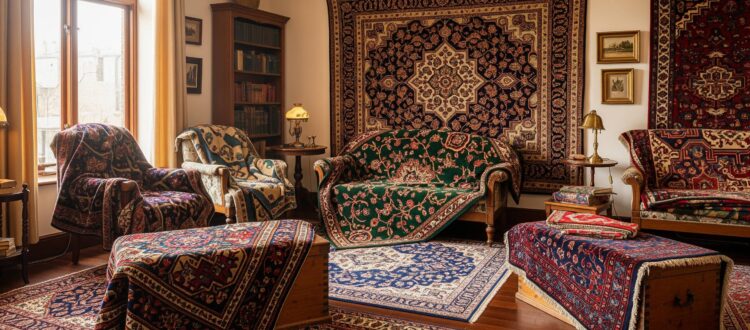The Language Of Colours In Antique Rugs And Carpets
We live in a world filled with colours. From the vivid colours of flowers, lakes, and nature to the bright colours of our interiors, we live in a beautiful world.
Nowhere is this truer than in antique rugs. When we talk about carpet colours, we see that every hue tells a story, every thread holds meaning, and every design carries centuries of tradition.
Symbolism in antique rug colours is deep. Red isn’t just red; it’s passion. Blue isn’t just blue; it’s protection. Antique rugs and carpets are not just floor coverings. They are a work of art. In this guide, we’ll break down the discover the psychology of rug colours, explore what different hues symbolise, trace their origins, and share expert tips for decorating with them.

The Psychology of Colours
Colours have powerful symbolic meanings that can influence human behaviour and emotions.
Colour psychology is the study of how different colours affect human mood and behaviour. It explores how colours can influence emotional responses.
In the world of antique rugs, colour is never random. Each dye was carefully sourced from natural plants, minerals, or insects, and every choice had meaning: spiritual, cultural, or social.
Also Read: Rug Motif & Symbolism
A Rainbow of Colours
Antique and vintage rugs and carpets come in a variety of colours and shades. Different cultures have used different colours to represent their values and beliefs.
We will look at some of the most common colours used in antique carpets and what they symbolise:
- Red Carpets: The Fire of Life

Red carpets and antique rugs have a profound meaning and are the result of a long tradition of craftsmanship.
Colour origin: Crafted through pigments available in nature, such as madder plant root, cochineal and even cherries.
Symbolism: The colour red symbolised power and wealth in many cultures. It also symbolises courage, vitality, and love
Found In: Persian carpets, Turkish carpets, Indian carpets, Nepalese carpets, among others.
Motifs and Designs: Red is often used as a base field colour in Persian carpets or as bold geometric accents in Turkish rugs. Some popular motifs in red antique carpets are dragon, phoenix, and mandarin chicken.
Decor Tip: Decorate with care and balance. There must be harmony in design. Take care that the design is not overpowering
- Blue Carpets/Indigo Carpets: The Colour of Protection

The history of indigo carpets is tied to the ancient origins of indigo dye, found in India. The Indigo dye, with its complex extraction and processing, made it a luxury, and it became integral to the weaving traditions of the Persian Empire and later the Mughal Empire in India.
Colour origin: Derived from plants in the Indigofera genus, indigo dye was a prized, globally traded commodity known as “India’s blue gold“
Symbolism: Blue is a colour that symbolises tranquillity and peace. Blue also symbolises love and fidelity. It also symbolises loyalty, spirituality, immortality, and protection from evil.
Found in: India is a major producer and seller of indigo carpets. The style can be found in other weaving traditions, like Persian carpets, as well.
Motifs and Designs: Blue colour is used to showcase floral motifs as it enhances the beauty of flowers. Some other popular motifs are the Tree of Life, the Medallion and the Boteh (Paisley) motif.
Decor Tip: Perfect for bedrooms or studies to create a serene, reflective space.
- Green Rugs: Sacred Renewal
Green carpets symbolise vivid imagery of lush nature, creating a welcoming atmosphere.
The ancient Egyptians believed that green represented life.
Colour Origin: Achieved by overdyeing indigo with yellow plant dyes like weld or saffron.
Symbolism: Throughout the world, green is a colour rooted in prosperity, balance, health and growth. It represents life and rebirth.
Found In: Major Indian carpets from regions like Bhadohi and Jaipur.
Motifs and Designs: Found in borders and field patterns, floral motifs, and geometric shapes
Decor Tip: Great for sunrooms, kitchens, or offices.
- Yellow & Golden Rugs: The Sun of Wealth

Yellow and gold, two colours that may look similar but are actually different. Yellow represents happiness and energy, while gold represents opulence and refinement.
Colour Origin: Yellow was derived from pomegranates, vines, Saffron and a flower called Ox-eye chamomile.
Natural gold and its adjacent colours were derived from natural sources like Ochre, Sienna and vegetable dyes.
Symbolism: Prosperity, joy, power, and the harvest.
Found in: These colours are found in Persian, Oriental and Indian carpets
Motifs and Design: Common motifs in yellow carpets vary by style, including vibrant florals and geometric patterns.
Decor Tip: Gold rugs bring a regal aura to formal spaces.
- Brown Rugs: Grounded Earth
The colour of the soil, brown, represents Mother Earth.
Colour Origin: Walnut husks, oak bark, or natural wool tones.
Symbolism: Simplicity, humility, endurance, and connection to the earth.
Found In: Found in Moroccan Berber rugs and tribal weavings, and Persian and oriental rugs.
Motifs and Designs: Classic floral and geometric patterns to natural textures and abstract art.
Decor Tip: A brown rug suits bohemian, farmhouse, or rustic interiors.
- Black Rugs: The Drama of Depth
Black is a powerful colour symbolising darkness.
Colour Origin: Oak galls, iron-rich mud, or tannin-based dyes.
Symbolism: Strength, power, defiance, and sometimes mourning.
Found In: Very rarely found in Persian and Oriental rugs, as it represents death
Motifs and Designs: Often used in Caucasian tribal rugs to outline bold geometric motifs.
Decor Tip: Use black rugs in modern, minimalist spaces for a striking effect.
- Orange Rugs: Endurance & Energy
Orange rugs are associated with fertility and growth, along with wealth, abundance, happiness, and spirituality.
Colour Origin: Blend of madder red and yellow plant dyes.
Symbolism: Devotion, strength, enthusiasm.
Found In: Indian carpets and carpets throughout Asia, and Persian carpets
Motifs and Designs: Floral and nature motifs like the Tree of Life, geometric motifs and animal motifs.
Decor Tip: Adds vibrancy to bohemian or eclectic interiors.
- White & Ivory Rugs: The Light of Purity
White is universally accepted as the colour of purity and innocence.
Colour Origin: Natural undyed wool, cotton, or silk.
Symbolism: Purity, peace, innocence, and clarity.
Found In: Primarily Persian and Turkish rugs.
Motifs and Designs: Common motifs include the Tree of Life, geometric medallions, and elaborate floral patterns.
Decor Tip: Great for bedrooms or small rooms, for a minimalistic look.
- Purple Rugs: Royal Mystique

Purple is often used as a symbol of royalty, wealth, and luxury.
Colour Origin: Origin: Rare and costly, usually created by over-dyeing indigo with madder.
Symbolism: Royalty, spirituality, wisdom, and power.
Found In: Purple carpets are found in various regions, like Saudi Arabia, Persia, India, Morocco and other regions.
Motifs and Designs: Traditional motifs like Herati, Floral and medallion motifs, along with geometric and abstract motifs.
Decor Tip: Perfect for making a statement in libraries, lounges, or meditation spaces.
- Grey & Silver Carpets: The Shade of Balance
Grey carpets are associated with balance, calmness, and sophistication.
Colour Origin: Often achieved through natural undyed wool from grey or black sheep.
Symbolism: Neutrality and balance, Intellect and wisdom.
Found In: Persian tribal rugs, Moroccan rugs, and Scandinavian flatweaves.
Motifs and Designs: Grey fields or borders often highlight brighter colours in geometric or floral designs.
Decor Tip: Grey carpets are versatile — they blend effortlessly into modern, industrial, or minimalist interiors.
Also Read: Carpet Décor Tips
Antique and Vintage Rug: The Legacy Lives On
Today, even with mass-produced rugs and carpets, the legacy of natural coloured, hand-woven rugs lives on. There is something magical about owning a vintage rug, one of its kind, made with natural fibres and colours. They are more than just home décor — they are woven masterpieces where colour, history, and symbolism meet.
Whether you are drawn to a fiery red carpet or a calm blue carpet, each colour has its own meaning and symbolism.
Whether you’re collecting rugs, designing a space, or simply appreciating their artistry, remember: every antique rug is a living canvas of colour, history, and soul.






